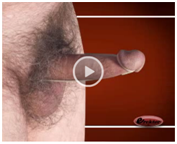How to perform TURP? (post)
step-by-step operative urology series
this is a post for those who do not like to read presentation
TURP set
- Lens
- Resectoscope sheath 24-Fr or 27-Fr. (single flow or continous flow).
- HF resection electrodes: band electrode & roller electrode (coagulation).
- Ellic evacuator
- Electrolyte-free and sterile irrigation fluid.
- Lubricant.
- Optional suprapubic catheter (12-Fr) for continuous irrigation.
Position
Right position (45 degrees) Wrong position (extended lithotomy)
Continence mechanism
The three components of the sphincter mechanism are:
Øbladder neck
Øintramural external sphincter (just distal to the verumontanum)
Ølevator ani.
Basic skills for TURP
Cutting a chip
1.lift the resectoscope to allow the loop to sink in
2. keep it level as you cut the chip
3.depress the sheath to cut off the chip.
The shape of the chip is like a canoe. It is as wide and deep as the loop, and its length is determined by the travel of the loop.
Cutting the chip off before the loop enters the sheath prevents any possible damage to the telescope.
Bleeding control
•Smaller vessel may be controlled by coagulating its mouth.
larger vessel is controlled by applying the loop just to one side of wall to seal the walls together.
•When artery points straight at you all you can see is a red blur.
•advance sheath, tilt it to squeeze vessel, coagulate just upstream.
If localization of bleeding site is difficult consider ‘Bouncing bleeding’.
Prophylactic coagulation sites
Main Steps of TURP
1.Identification of landmarks.
2.Removal of most of adenoma (stepwise) by Mauermayer technique or Nesbit technique.
3.Tidying up & removal of apical tissue.
4.Catheter application
Initial steps & Identification of landmarks

•Lithotomy position.
•Blind trocar or visual insertion of the resectoscope sheath.
•Urethrocystoscopy with identification of verumontanum, prostatic urethra, bladder neck and ureteral orifices.
•The external sphincter is easily identifiable at the level of the membranous urethra.
•It is necessary to be aware of the position of the verumontanum to see that the lower part of the cut is not extending below this level, otherwise damage to the sphincter mechanism may occur.
Mauermayer Standard technique (1981)
Idea:
•Resection in lobes (middle lobe & tissues lat. to veru. → Lt lobe→ Rt → lobe apical tissues).
•apical tissues last
•Resection begins at the proximal portion of the middle lobe at the 6 o’clock position.
•The resectoscope is placed just proximal to the verumontanum and the resection carried out always controlling the endpoint of each cut.
•Continue resecting the middle lobe from the 7 to 5 o’clock positions.
•Resection at both sides of the verumontanum with particular care of the position of the external sphincter (do not exceed distal end of verumontanum).
•pull the resectoscope into the urethra, just distal to the verumontanum, and note that there is no falling and obstructing tissue.
Resection of Left lateral lobe (proximal part) in long cuts next to each other to achieve smooth surface (fossa).
•Which lobe first? depends on the preference of the surgeon.
Resection of Right lateral lobe (proximal part) in long cuts next to each other to achieve smooth surface (fossa).
•Shape of surface (fossa) after resection proximal part of both lateral lobes in long cuts.
•Resection of apical tissues carefully (do not exceed distal end of verumontanum)- finger in rectum can approximate the apical tissues.
Nesbit Standard technique (1943)
Idea:
•Resection from proximal to distal (BN → midportion → apical tissue).
•apical tissues last.
1st stage: resect BN
•Resect BN in quadrants starting at 12 o’clock (until see circular fibers of BN)
2nd stage: resect midportion in quadrants, (superiorly to inferiorly) (until see fibers of prostatic capsule)
(a): Rt lobe upper quadrant (12 to 9 o’clock)
(b): Lt lobe upper quadrant (12 to 3 o’clock)
(c): Rt lower quadrant (9 to 6 o’clock) & Lt lower quadrant (3 to 6 o’clock)
3rd
stage: resect
apical tissues
Residual
tissue is carefully cleared on both sides immediately lateral to veru
(do
not exceed distal end of verumontanum
to preserve sphincter).
—begin
next to the veru
→ toward the 12 o'clock position
Catheter application
place a 20 F three-way catheter for drainage; can be inserted with the finger in the rectum, pressing the prostatic tissue up to avoid damage to the bladder neck and trigone.
The balloon is inflated to 20 mL or 30 mL
the catheter can be left at bladder neck or withdrawn in the prostatic fossa.
Balloon catheter within the bladder (with traction on BN to contract the fossa)
this is the preferred method by most of the surgeons because it allows the capsule to contract without much trauma to the urethra.
Balloon catheter within the prostatic fossa
some surgeons advocate that method to control bleeding (only for short time).
However, Prolonged traction with the balloon in prostatic fossa has the risk of traumatic injury & prevent fossa contraction leading to bleeding.
Skin traction
some surgeons advocate traction to be maintained by a gauze swab tied round the catheter and pulled back onto the glans penis (for short time to avoid ischemia).































